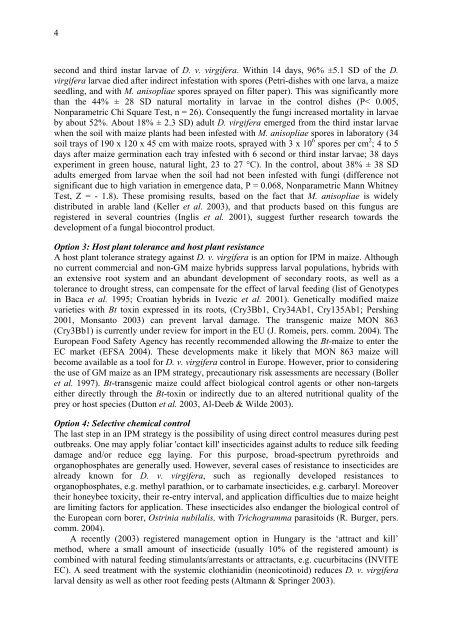IOBC/wprs Bulletin Vol. 28(2) 2005
IOBC/wprs Bulletin Vol. 28(2) 2005
IOBC/wprs Bulletin Vol. 28(2) 2005
Create successful ePaper yourself
Turn your PDF publications into a flip-book with our unique Google optimized e-Paper software.
4<br />
second and third instar larvae of D. v. virgifera. Within 14 days, 96% ±5.1 SD of the D.<br />
virgifera larvae died after indirect infestation with spores (Petri-dishes with one larva, a maize<br />
seedling, and with M. anisopliae spores sprayed on filter paper). This was significantly more<br />
than the 44% ± <strong>28</strong> SD natural mortality in larvae in the control dishes (P< 0.005,<br />
Nonparametric Chi Square Test, n = 26). Consequently the fungi increased mortality in larvae<br />
by about 52%. About 18% ± 2.3 SD) adult D. virgifera emerged from the third instar larvae<br />
when the soil with maize plants had been infested with M. anisopliae spores in laboratory (34<br />
soil trays of 190 x 120 x 45 cm with maize roots, sprayed with 3 x 10 6 spores per cm 2 ; 4 to 5<br />
days after maize germination each tray infested with 6 second or third instar larvae; 38 days<br />
experiment in green house, natural light, 23 to 27 °C). In the control, about 38% ± 38 SD<br />
adults emerged from larvae when the soil had not been infested with fungi (difference not<br />
significant due to high variation in emergence data, P = 0.068, Nonparametric Mann Whitney<br />
Test, Z = - 1.8). These promising results, based on the fact that M. anisopliae is widely<br />
distributed in arable land (Keller et al. 2003), and that products based on this fungus are<br />
registered in several countries (Inglis et al. 2001), suggest further research towards the<br />
development of a fungal biocontrol product.<br />
Option 3: Host plant tolerance and host plant resistance<br />
A host plant tolerance strategy against D. v. virgifera is an option for IPM in maize. Although<br />
no current commercial and non-GM maize hybrids suppress larval populations, hybrids with<br />
an extensive root system and an abundant development of secondary roots, as well as a<br />
tolerance to drought stress, can compensate for the effect of larval feeding (list of Genotypes<br />
in Baca et al. 1995; Croatian hybrids in Ivezic et al. 2001). Genetically modified maize<br />
varieties with Bt toxin expressed in its roots, (Cry3Bb1, Cry34Ab1, Cry135Ab1; Pershing<br />
2001, Monsanto 2003) can prevent larval damage. The transgenic maize MON 863<br />
(Cry3Bb1) is currently under review for import in the EU (J. Romeis, pers. comm. 2004). The<br />
European Food Safety Agency has recently recommended allowing the Bt-maize to enter the<br />
EC market (EFSA 2004). These developments make it likely that MON 863 maize will<br />
become available as a tool for D. v. virgifera control in Europe. However, prior to considering<br />
the use of GM maize as an IPM strategy, precautionary risk assessments are necessary (Boller<br />
et al. 1997). Bt-transgenic maize could affect biological control agents or other non-targets<br />
either directly through the Bt-toxin or indirectly due to an altered nutritional quality of the<br />
prey or host species (Dutton et al. 2003, Al-Deeb & Wilde 2003).<br />
Option 4: Selective chemical control<br />
The last step in an IPM strategy is the possibility of using direct control measures during pest<br />
outbreaks. One may apply foliar 'contact kill' insecticides against adults to reduce silk feeding<br />
damage and/or reduce egg laying. For this purpose, broad-spectrum pyrethroids and<br />
organophosphates are generally used. However, several cases of resistance to insecticides are<br />
already known for D. v. virgifera, such as regionally developed resistances to<br />
organophosphates, e.g. methyl parathion, or to carbamate insecticides, e.g. carbaryl. Moreover<br />
their honeybee toxicity, their re-entry interval, and application difficulties due to maize height<br />
are limiting factors for application. These insecticides also endanger the biological control of<br />
the European corn borer, Ostrinia nubilalis, with Trichogramma parasitoids (R. Burger, pers.<br />
comm. 2004).<br />
A recently (2003) registered management option in Hungary is the ‘attract and kill’<br />
method, where a small amount of insecticide (usually 10% of the registered amount) is<br />
combined with natural feeding stimulants/arrestants or attractants, e.g. cucurbitacins (INVITE<br />
EC). A seed treatment with the systemic clothianidin (neonicotinoid) reduces D. v. virgifera<br />
larval density as well as other root feeding pests (Altmann & Springer 2003).

















